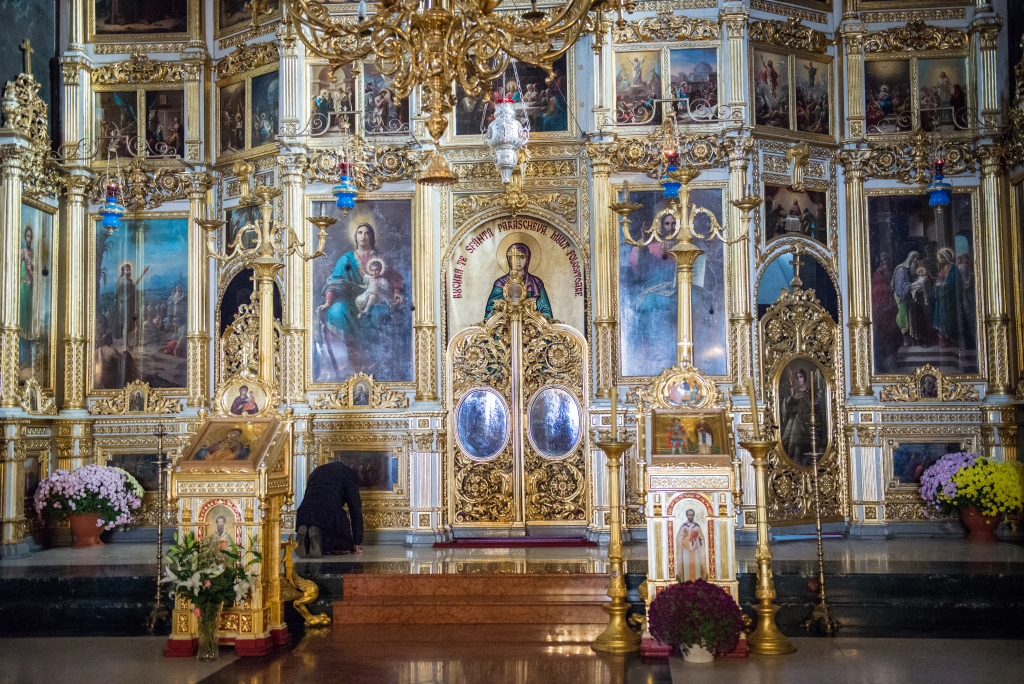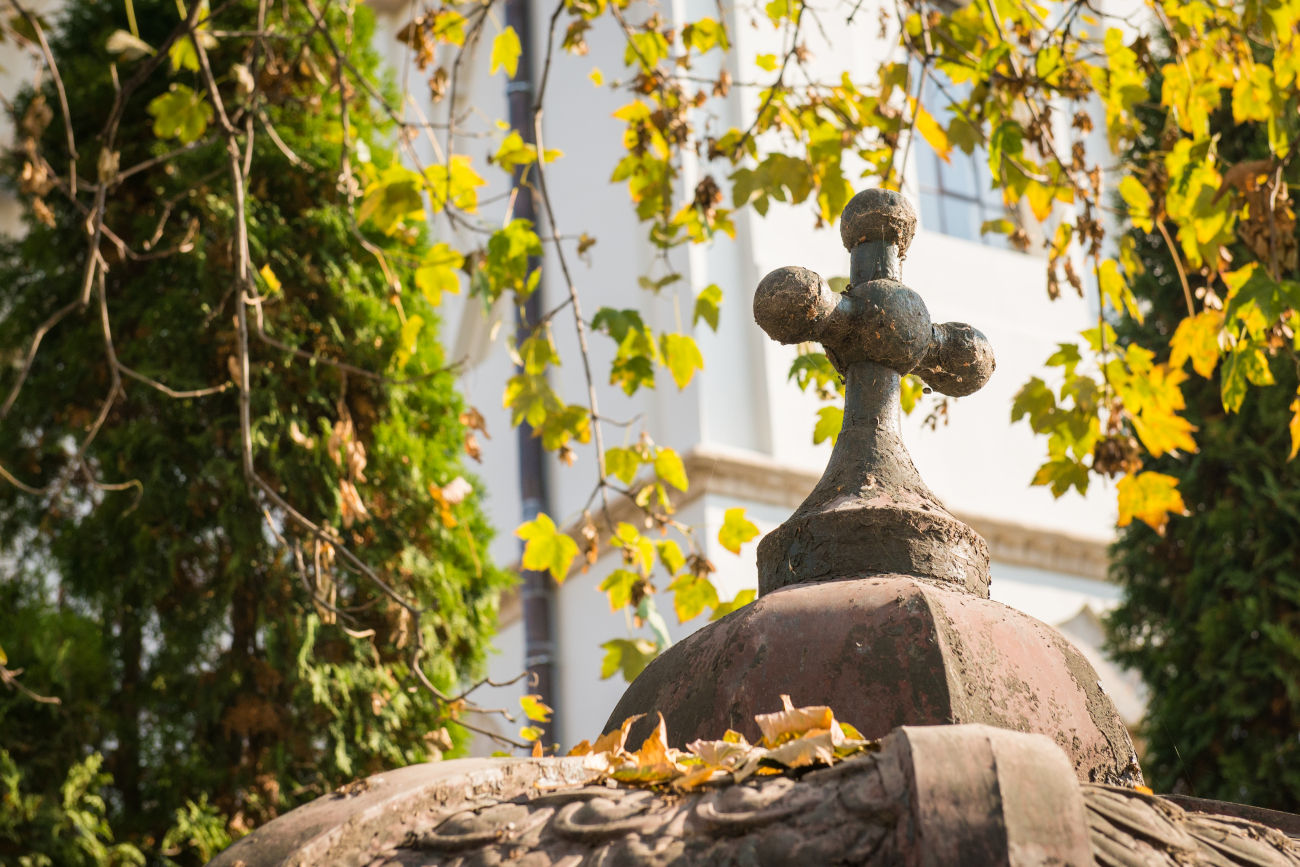The Lights of the Cathedral
Inside the Cathedral, the neoclassical sobriety of the architectural elements meets the iconographic style, which is a bright synthesis of spiritual realism bringing together the Orthodox ‘hermeneia’ and the Italian academism. Master Gheorghe Tattarescu (1818-1894) reached here the climax of his artistic creation, due to the refined appearance of the lines and colours, and also the imagistic richness.
In the narthex of the Cathedral, looking to the vault we meet Father the Almighty in His glory displayed on the firmament with the Earth Globe on His feet. Left and right are painted in oil two biblical scenes preparing us to meet God in the house of His glory: the Parable of the Prodigal Son, to the right, and the Parable of the Pharisee and the Tax Collector, to the left. Two marble plaques mounted on the wall that separates the narthex from the nave are a type of founder’s inscription, presenting the history of the founding of the holy building, its founders and the day of the consecration, 23 April 1887.
The central nave and the two lateral naves are adorned with pictorial elements adapted to the size of the different areas: icons of saints and angels, biblical scenes, ornamental motifs, over 250 icons and compositions that ornate the walls, vaults, pillars and iconostasis. The sunlight reaches the interior of the Cathedral through ten large stained glass windows.
In accordance to the Orthodox tradition, at the entrance, in the central nave, we find the founders’ portraits of King Carol I and Queen Elisabeta, to the right, and metropolitans Veniamin Constachi (1803-1842) and Iosif Naniescu (1875-1902), to the left. On the pillars in the western and southern areas we find full-sized depictions of martyrs and holy men, which instil peacefulness, kindness and spiritual purity into the minds of the faithful.
The four vaults of the holy building are adorned with ample compositions illustrating people and crucial events in the history of salvation: the drama of Lucifer’s fall, the 24 elders of the Book of Revelation, the Christ Pantocrator accompanied by angels, holding the A to Ω book of divine wisdom, the Holy Trinity accompanied by angels singing “Holy, Holy, Holy Lord of Sabaoth!”
The lateral walls of the nave are covered by compositions inspired by biblical themes: the Descent of the Holy Spirit, the Transfiguration, the Birth of our Lord, the Adoration of the Magi, the Flight to Egypt, the Descent from the Cross, the Way to the Tomb and the Resurrection of our Lord.
The surfaces of the transversal and longitudinal arches and of the two pulpits are decorated with more than 100 medallions with portraits of saints, on a landscape background or an imitation of gilded mosaic. On the half-dome of the central apse one can see a depiction of the Theotokos, “she who is higher than the heavens”, holding her Son. On the round surface of the central apse there are illustrations drawn from the Old Testament (Abraham’s Sacrifice and Jacob’s Dream), from the New Testament (the Last Supper, the Washing of Feet) or from the history of the Church: the holy apostles Peter and Paul, James and John, the holy hierarchs Basil the Great, John Chrysostom, Gregory the Dialogist, Athanasius and Cyril, and the holy archdeacons Stephen and Laurence.
The majestic beauty of the painting is supplemented by the liturgical objects that adorn the church: the episcopal and royal thrones, the chandeliers and candelabra of silver-plated and gold-plated bronze, the liturgical vestments, the vigil lamps and the liturgical sacred vessels.
The iconostasis of the Church is made of 49 icons presented on five rows. The first row contains small icons illustrating aspects from the life of the holy people portrayed in the row above. Two large icons follow: our Lord Jesus Christ, to the right of the imperial doors, and our Lady Theotokos to the left. The corresponding small icons of the first row represent the scene of our Lord’s meeting the children and Elizabeth’s Praise of Mary. The icon of the Presentation of our Lord on the southern side represents the patronage feast of the old church founded here in 1695. Below there is a depiction of the Adoration of the Magi. Next to it, we can see the icon of St George the Victory-Bearer, above the scene that illustrates the Wonder of the destruction of the idols. On the other side there is an icon portraying St John the Baptist (with a painting of our Lord Jesus Christ revealing Himself to the crowd) and the icon of St John the New of Suceava, with a picture describing his passion.
On the imperial doors there is a representation of the Annunciation, while on the diaconal doors we can find the portraits of Archangels Michael and Gabriel.
The third row is made of 12 icons of the Great Feasts, with the Last Supper in the centre. The other two rows respect a similar symmetry: a central icon, flanked by six other icons on either side.
On the fourth row our Lord Jesus Christ is accompanied by the twelve apostles, and on the fifth row the icon of the Holy Trinity is flanked by portraits of the Old Testament prophets.
Between two pendants, above the uppermost row, one can see the icon of the Resurrection of our Lord, who appears to the myrrh-bearing women. On top of the iconostasis there are depictions of our Lord Jesus Christ on the Cross and of the two broken-hearted witnesses of His Passion: His Holy Mother and Apostle John.
The sculptural ornaments of the iconostasis are gold-plated and discreetly brighten the entire iconographic complex.
However, the crown jewel of the Cathedral is the casket with the relics of St. Parascheva, the Bountiful Helper, by the grace that God bestows upon the people as a result of her intercession. The holy relics were transferred to the Cathedral from the Three Holy Hierarchs Monastery at the beginning of 1889 and were placed on the southern side of the nave, between the wall and the fourth pilaster.
St Parascheva was born in Epivata on the shore of the Sea of Marmara, during the first half of the 11th century. Although she died only at the age of 27, her ascetical endeavours and her insatiable quest for spiritual fulfilment won her the grace of God. She embraced the monastic life in a monastery of Constantinople, adorning her soul with the virtues of prayer, fasting and charity. After spending five years at the Monastery of the Theotokos in Heraclea (Pontus) she went to the Holy Land in order to pray there, then, on divine request, came back to her native land where she eventually ended her earthly sojourn.
Her precious relics were miraculously unearthed and were placed to be venerated in the Church of the Holy Apostles in Epivata. The faithful went there as if to find a source of healing and of spiritual help. Around 1328, the relics were brought to Tarnovo by the Vlach-Bulgarian Tsar John Asen II (1218-1241). 120 years later, they were transferred to Belgrade and then, in 1520, to Constantinople. Voivode Vasile Lupu of Moldavia (1634-1653), a benefactor and patron of the Ecumenical Patriarchate, was given in gratitude the casket with the relics of St Parascheva, which was transferred to Iași in 1639 and placed with great honors in the newly built Church of the Three Holy Hierarchs. Following a fire at the end of year 1888, when the holy relics remained unscathed, they were moved to the new and recently consecrated Metropolitan Cathedral.
A source of spiritual remedies, of peace and blessing, St Parascheva is venerated as a true guardian of Iași and the whole of Moldavia. On 14 October pilgrims from everywhere come to share in the joy of the Feast of the Cathedral and to thank St Parasheva for helping the people who pray to her. Indeed the spirit of prayer and of spiritual joy is present each and every day in the Cathedral, as the divine services are following here too the monastic typicon.
The general recognition of St Parascheva’s veneration on a national level was proclaimed in 1955 in the Cathedral of Iași. After 1990 several new Romanian saints were solemnly proclaimed here: St Teodora of Sihla and St Ioan of Neamț (1992), St. Petru Movilă, Metropolitan of Kiev (2002) and St. Dosoftei, Metropolitan of Moldavia (2005).
Starting with 1996, through the efforts of His Eminence Daniel, Metropolitan of Moldavia and Bucovina, the Feast of St Parascheva has become an occasion for saints to be in communion with each other and with the pilgrims, as other beloved relics were brought for the event, from various Christian lands: St Apostle Andrew (1996), St George the Great Martyr (2000), the Venerable Belt of the Most Holy Theotokos (2001), St John Cassian (2002), St. Demetrius the Great Martyr (2003), the Holy Cross (2004), St Paul (2005), St Nectarius the Wonderworker (2006), St John Chrysostom (2007).
Many fragments of relics were offered as a gift to the Metropolitanate on these occasions. They are held in high regard and displayed for veneration next to the casket with St Parascheva’s relics.
During the 120 years since the consecration of the Cathedral a number of reparations have been executed, most notably after the World Wars and the 1977 earthquake. In 1995 was initiated a large-scale project of consolidation and restoration of the holy building. The groundwork and the towers were consolidated and a new area was created on the lower ground floor to serve as the necropolis of the metropolitans of Moldavia. The remains of the former hierarchs of Moldavia will be brought here and interred next to the founders of the Cathedral, metropolitans Veniamin Costachi and Iosif Naniescu. The remains of the former are resting now on the inside of the church, in a recess of the nave, and those of the latter on the outside, near the southern wall of the church.







